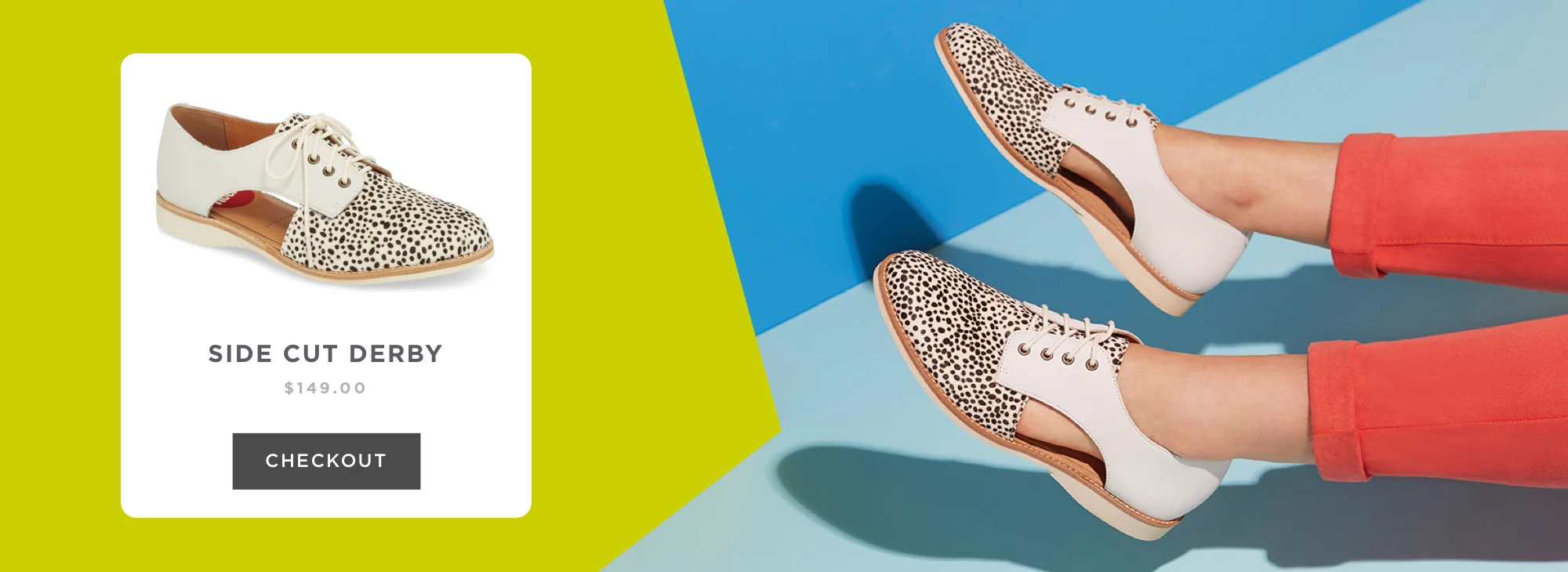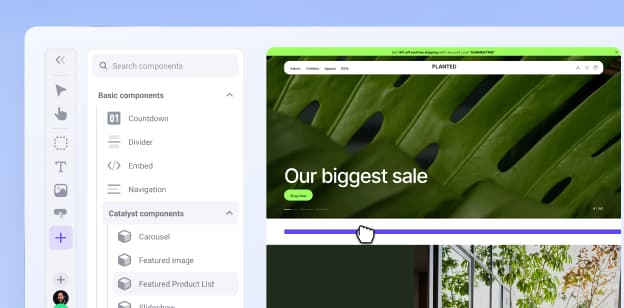Ecommerce Store Inspiration: Designs We Love + Sites With Awesome Functionality

The popular lore tells that good artists borrow, great artists steal.
But it’s actually an ongoing misquoting. Steve Jobs misquoted Picasso, who rephrased Igor Stravinsky, who was probably reiterating on T.S. Eliot’s words, which sounded like this:
“The good poet welds his theft into a whole of feeling which is unique, utterly different than that from which it is torn.”
In other words, it’s okay to get inspired by the work of others and then creatively transform it into something of your own.
What Makes a Great Ecommerce Site?
Launching an ecommerce store means making so many important decisions — both technical and creative.
You need to choose an ecommerce platform, find a store template that matches your needs, add custom design elements, plugins, extensions and other configurations.
And then there are countless things that you could tweak: typography, header, homepage, landing pages, product categories, product pages, product images, shopping cart, call-to-action (CTA) buttons, checkout process, pop-ups, etc.
Here are five important elements of a great ecommerce store.
1. Beautifully designed.
Would you want to buy from a brick-and-mortar store that had broken windows, a messy storefront and cobwebs on the shelves? Probably not. And you would likely leave without even looking at their products.
Well, the same is true for ecommerce businesses, with their websites being their virtual storefronts. When a potential customer visits your online store, you need to make a positive first impression. otherwise, they will simply leave.
That’s why an investment in attractive ecommerce design is an investment in the success of your online business.
Great ecommerce website design should:
Use a color scheme and typography that matches your brand.
Include a lot of white space to make it easier on the eyes.
Have eye-catching call-to-action (CTA) buttons. Bright colors work best!
Follow the best conversion rate optimization practices.
SEO (search engine optimization) friendly.
Easy to share on social media.
Be user-friendly and mobile-friendly.
2. Fast. Fast. Fast.
Ecommerce businesses can’t afford slow websites. Why?
Check out this data from Google:
Source: Google
A two-second delay in page load time increases bounce rate by 32%.
This is not surprising given that 70% of consumers, page speed affects their decision to buy from an online retailer.
So if you want to make a sale, you need a fast-loading online store:
Choose a reliable ecommerce platform.
Install a CDN if you publish a lot of content.
Compress product images and videos.
Remember, when it comes to site speed, every second matters. Literally.
3. Many products to choose from.
Customers tend to unconsciously compare all ecommerce stores to Amazon. So they might come to your online shop expecting a wide product range.
Of course, you can’t compete with Amazon in that regard. But you need to make sure that you carry a good enough product range to engage them.
Set up an easy-to-browse product catalog featuring:
Clear navigation — categories, tags, filters
Advanced functionality — filters, search by size, color, material
Attractive visuals — clean design, beautiful color palette, product photography
4. Mobile-friendly.
Mobile traffic accounts for approximately half of all web traffic, hovering around the 50% mark since the beginning of 2017. If your website isn’t mobile-optimized, you risk losing a ton of potential customers.
Apart from using a responsive, mobile-friendly website theme, be sure to:
Adapt your layout for finger scrolling.
Use crisp pop-up product images.
Reduce the number of fields on the checkout page.
Include big call-to-action buttons (e.g., add-to-cart button).
5. User-generated reviews.
User-generated content (UGC) such as customer reviews are a must-have for an ecommerce store. Why? Because the volume of product reviews increases the conversion rates. Though the first five reviews seem to have the biggest impact.
Source: Spiegel Research Center
Include a review section on your website and encourage customers to leave their feedback!
21 Examples of Ecommerce Stores We Love
Okay, so now that we have discussed the most important things that you need to focus on, let’s take a look at how successful ecommerce businesses present themselves online.
Here are 21 of the best ecommerce website examples featuring some incredible small businesses to get inspired by!
1. Solo Stove.
Source: Solo Stove
Solo Stove specializes in ultra-efficient grilling equipment, camping stoves and fire pits.
The company was founded by Jeff and Spencer Jan who spent a lot of time camping outdoors as they were growing up. Later in life, they wanted to recreate that adventurous vibe with their family.
As John Merris, Solo Stove CEO, explained to BigCommerce:
“Our product encourages people to go make memories with their loved ones. You typically don’t see people sitting around a fire by themselves — they normally are with friends and family. There’s something really cool about that.”
Solo Stove emphasizes this sense of togetherness on their website. It’s full of images of people sitting around by the fire, enjoying delicious food and sharing stories and laughter.
2. LARQ.
Source: LARQ
LARQ’s co-founder and CEO Justin Wang is an avid hiker who is also passionate about the environment and our impact on it. He tried going completely plastic-free but that was challenging. Reusable bottles got dirty too fast and were hard to clean. No wonder there was an adoption problem in the reusable bottle industry!
One of the most interesting features of the LARQ online store is the calculator on the homepage. You put in the number of water bottles that you go through each week and are then shown how much money you could save by getting yourself a LARQ bottle instead. It also tells you by how much you could reduce plastic bottle waste and your carbon footprint.
3. Burrow.
Source: Burrow
While in business school, Kabeer Chopra and Stephen Kuhl needed to buy furniture for their new apartment. They realized that they had two options available to them: get something inexpensive and disposable, or get high-quality furniture but risk having to wait for it for up to 12 weeks.
The above experience prompted them to start Burrow with a vision of eliminating the hassle of furniture shopping by selling modular furniture online.
On their homepage, they display an animation that shows how their Range collection products can be adjusted to fit any space. It helps the potential customer understand what modular design is all about.
4. Skullcandy.
Source: Skullcandy
Skullcandy sells high-quality earphones and headphones (both wired and wireless). The company’s website features a bold web design, engaging copy and click prompting “Inside Skullcandy” section where you can learn more about their team, values, culture and charitable partnerships.
Skullcandy is a great example of ecommerce branding done right. Every element of their online presence is consistent with and contributes to their overall positioning.
5. Bon Bon Bon.
Source: Bon Bon Bon
Bon Bon Bon sells artisanal candy made by using classic French technique, local ingredients and creativity.
This company serves as a reminder that you don’t have to compete on price if you can create a brand image that resonates with your target audience.
With a 10-piece box costing $35, their bonbons aren’t cheap. But the business is thriving because the company is making exceptional-quality products and selling them to people who appreciate that quality and are willing to pay for it.
Bon Bon Bon’s website design captures the spirit of their brand perfectly. Vintage elements, unique typography and endless bon bon images show the team’s artistic side, their passion for their craft and their sense of humor. All this adds to their creative, casual and fun brand image that their customers can relate to.
6. Body Bliss.
Source: Body Bliss
Body Bliss sells a range of skincare products, made from natural, sustainable ingredients, sourced locally.
Their “About” page is a great example of how to convey brand values to potential customers. It’s minimalistic and consists of two images — a note from the CEO and an explanation of the symbolism behind their logo. But that’s enough to immediately understand what BodyBliss is all about.
7. Black Diamond Equipment.
Source: Black Diamond Equipment
Black Diamond Equipment sells climbing, skiing and snowboarding equipment as well as shoes and apparel.
Their homepage features an immersive video of John Jackson riding a snowboard on Mount Adams. You can’t help but feel the call of the great outdoors as you are watching it!
There’s a sales lesson in there: nothing is more convincing than showing the potential customer what their life could be like.
8. Tommie Copper.
Source: Tommie Copper
Tommie Copper sells compression clothing that provides support when recovering from injuries or engaging in strenuous physical activity.
And they are one of the few ecommerce retailers with a 60-day no-questions-asked money-back guarantee. That’s a great way to instill extra confidence in your customers and demonstrate your commitment to product quality.
9. Natori.
Source: Natori
Natori is a luxury apparel store that has been selling to wholesalers for over 40 years and directly to consumers for over 10 years.
But they also keep up with the emerging tech trends in retail. As Heidi Maund, previously the director of ecommerce at Natori, explained in her post on our blog:
“Whether it’s virtual reality, artificial intelligence, or any of the other exciting new things happening in digital commerce, taking advantage of them can really help drive your business forward.”
Natori also does a great job at positioning themselves as a classy and elegant brand by displaying carefully chosen, tasteful product images on their homepage.
10. Hyphen Sleep.
Source: Hyphen Sleep
Hyphen Sleep sells cutting-edge mattresses that were designed based on sleep data research, built with custom materials and went through extensive product testing.
It’s a hip and youthful brand. They reinforce this image with bright colors, white space and photos of young, cool, active people. This creative approach helps them stand out in their industry.
11. Autograph Foliages
Source: Autograph Foliages
Autograph Foliages is a family-owned company that sells artificial plants including grass, flowers and trees.
Note how perfect their color scheme is. The green details work so well with product images of various artificial plants.
12. Berlin Packaging.
Source: Berlin Packaging
Berlin Packaging is a family business that was founded in 1938.
Their web design allows them to present themselves as a serious and reliable B2B company without coming across as stale and boring. White space helps a lot with this by making the website look clean and modern.
13. Anchor and Crew.
Source: Anchor and Crew
Anchor and Crew sell jewelry, leather goods and accessories for adventurous people. They take pride in their ethical, traceable and transparent supply chain that allows their celebrated artisans to handcraft their products from high-quality materials sourced consciously.
This ecommerce store is another example of how unique branding, quality materials and the right marketing strategy can allow a business to charge premium prices for their products.
14. Beer Cartel.
Source: Beer Cartel
Beer Cartel sells craft beers and glassware.
Its simple web design helps to create a casual, laid-back brand image that resonates with craft beer enthusiasts. No bells and whistles, just good beer!
15. Di Bruno Bros.
Source: Di Bruno Bros.
Di Bruno Bros. has been selling gourmet food for more than 75 years. They were also one of the first gourmet food retailers to start selling online in the early 2000s.
Their web design puts gourmet food front and center. There’s a variety of appetizing images on their homepage. You can’t help but feel tempted to buy some artisanal cheese.
16. Marucci Sports.
Source: Marucci Sports
Marucci Sports sells baseball and fastpitch equipment.
Note the “Commitment to Players” section on their homepage. They explain that they are a company founded and operated by current and former Big Leaguers. This helps Marucci Sports establish their authority as experts and build trust with their customers.
17. Barron Designs.
Source: Barron Designs
Barron Designs sells faux panels and faux columns as well as wood and faux wood beams. They strive to provide innovative, affordable and high-quality faux building materials to their customers.
One of the most interesting features of their ecommerce store is the “What’s Your Design Style?” quiz. You are presented with several questions where you need to choose the image that you like best. You then get your quiz results with your favorite style (e.g., Modern Coastal).
18. Tyler’s.
Source: Tyler’s
Tyler’s sells sports apparel. Pay attention to how they promote an active lifestyle through the use of relevant images on their homepage. It makes you want to go for a run.
19. Molton Brown.
Source: Molton Brown
Molton Brown sells luxury beauty, fragrance, bath and body gift sets. Note how tasteful web design helps to create an atmosphere of a luxury boutique. The product images are especially well done. They make it easy to imagine how these products would look in someone’s bathroom.
20. Scentos.
Source: Scentos
Scentos sells scented arts and craft supplies that feature unique cartoon characters. They are focused on providing sustainable and conscious products — from creation to delivery — and that serves as a strong differentiator among the competition.
21. Saddleback Leather Company.
Source: Saddleback Leather Company
Saddleback Leather Company sells leather products including wallets, bags and backpacks. There’s an interesting navigation solution on the homepage that features thumbnails with page names and relevant photos. This invites the customer to learn more about the company while reinforcing the brand image visually.
Expert Opinions On What Makes The Best Ecommerce Store
Care to know what the pros think? Here are two simple (yet very effective!) ecommerce store design tips, applicable for any industry.
1. Make products easily discoverable.
“When building your store’s catalog, make sure it is arranged in the way that customers actually search for your products, with the product attributes and types appearing in the metadata of the products. Check your search analytics to see what customers searches and find, and more importantly, what they don’t find, so you can fit your product building to real customers’ searches and navigation. Remember that the first results your shoppers see, be that in navigation or in search, highly affect their conversion rate so optimize these with best of breed merchandising apps.”
– Zohar Gilad (CEO & Co-Founder, InstantSearch+)
2. Achieve the best ecommerce store with headless commerce.
“Create a user experience that is modeled entirely around the goals of your business. Consumers are starting to expect a more tailored experience that puts great content at the forefront; the flexibility of headless commerce allows brands to deliver a customized user experience (UX) while still offering all the components of a traditional backend.”
– Michelle Rooker (Content Specialist, 5874)
Wrapping Up
So what’s the secret to creating a great ecommerce website?
Apply the 80/20 rule. Focus on what matters the most — usability, mobile-friendliness, unique design.
Study successful ecommerce companies. Consider how you can adapt their “best practices” to your business.
Actively seek out the opinion of proven ecommerce experts. Implement their advice.
Do these three things and you will soon be lightyears ahead of your competition!
Best Ecommerce Store Examples FAQs
1. What makes an ecommerce store great?
There are a lot of qualities that shoppers look for in an ecommerce store, but some of the foundational elements you’ll need to ensure are a clean, beautiful design that’s easy to use — even on mobile devices — and that loads quickly. An adequate product selection and social proof, like customer reviews, are great to have as well.
2. What are common issues with ecommerce stores?
One big problem with some ecommerce sites is page load speed. If your site speed is poor, that will impact your SEO ranking — not to mention annoy your customers.
3. Is Amazon an ecommerce store?
Yes. Amazon launched in the mid-1990s as a way to buy books online, but eventually expanded into almost every other product you can think of. Since then, though, Amazon has also become a marketplace — where third party sellers can sell their wares on Amazon.com — and an advertising platform.
4. What are examples of great ecommerce stores?
BigCommerce has a ton of great brands on its platform. A few of the ones we love are LARQ, Skullcandy and Solo Stove.
5. Are ecommerce stores difficult to make?
That depends on a number of factors, from your ecommerce platform to your industry to your specific requirements. When you’re looking for an ecommerce platform, make sure you have a detailed understanding of the functionality you’ll need, so you can understand how simple or complex it will be to accomplish on any particular platform. Many platforms have drag-and-drop editing functionality to limit the amount of coding you’ll have to do, but some are so customizable that they can get complex and require a lot of work from your team of developers.
6. Can you integrate an ecommerce store into social media platforms?
Yes. You can integrate your product mix into social media platforms to take advantage of their commerce functionality and put your brand and products in front of both new and existing customers.
7. What is an example of an online boutique?
Anchor & Crew is a great online boutique featuring an interesting and diverse product mix.
8. Can you sell sports equipment online?
Marucci Sports is a great example of a brand that uses ecommerce to sell sports equipment to customers wherever they are.
9. Can you sell beer online?
Legal restrictions on beer sales will depend largely on geography, so make sure to check your local laws and regulations. Beer Cartel in an online store in Australia that delivers craft beer to customers all over the country.
10. Can you sell ice cream online?
Believe it or not – yes!

Brett Regan is an experienced writer specializing in SaaS and ecommerce topics, with a strong focus on helping businesses navigate the digital landscape. His work covers a wide range of subjects, from ecommerce strategies to platform solutions and innovations in online retail. With years of expertise, Brett's writing provides valuable insights for businesses looking to grow and succeed in the fast-paced world of ecommerce.


